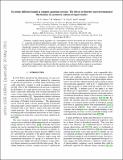| dc.contributor.author | Abasto, D. F. | |
| dc.contributor.author | Mohseni, Masoud | |
| dc.contributor.author | Lloyd, Seth | |
| dc.contributor.author | Zanardi, P. | |
| dc.date.accessioned | 2013-05-28T15:58:37Z | |
| dc.date.available | 2013-05-28T15:58:37Z | |
| dc.date.issued | 2012-07 | |
| dc.identifier.issn | 1364-503X | |
| dc.identifier.issn | 1471-2962 | |
| dc.identifier.uri | http://hdl.handle.net/1721.1/78940 | |
| dc.description.abstract | Symmetric couplings among aggregates of n chromophores increase the transfer rate of excitons by a factor n2, a quantum-mechanical phenomenon called ‘supertransfer’. In this work, we demonstrate how supertransfer effects induced by geometrical symmetries can enhance the exciton diffusion length by a factor n along cylindrically symmetric structures, consisting of arrays of rings of chromophores, and along spiral arrays. We analyse both closed-system dynamics and open quantum dynamics, modelled by combining a random bosonic bath with static disorder. In the closed-system case, we use the symmetries of the system within a short-time approximation to obtain a closed analytical expression for the diffusion length that explicitly reveals the supertransfer contribution. When subject to disorder, we show that supertransfer can enhance excitonic diffusion lengths for small disorders and characterize the crossover from coherent to incoherent motion. Owing to the quasi-one-dimensional nature of the model, disorder ultimately localizes the excitons, diminishing but not destroying the effects of supertransfer. When dephasing effects are included, we study the scaling of diffusion with both time and number of chromophores and observe that the transition from a coherent, ballistic regime to an incoherent, random-walk regime occurs at the same point as the change from supertransfer to classical scaling. | en_US |
| dc.description.sponsorship | United States. Defense Advanced Research Projects Agency (QuBE program, ENI) | en_US |
| dc.description.sponsorship | National Science Foundation (U.S.) | en_US |
| dc.description.sponsorship | United States. Office of Naval Research | en_US |
| dc.description.sponsorship | NEC | en_US |
| dc.description.sponsorship | Intel Corporation | en_US |
| dc.description.sponsorship | Institute for Scientific Interchange | en_US |
| dc.description.sponsorship | Santa Fe Institute (Santa Fe, N.M.) | en_US |
| dc.language.iso | en_US | |
| dc.publisher | Royal Society, The | en_US |
| dc.relation.isversionof | http://dx.doi.org/10.1098/rsta.2011.0213 | en_US |
| dc.rights | Creative Commons Attribution-Noncommercial-Share Alike 3.0 | en_US |
| dc.rights.uri | http://creativecommons.org/licenses/by-nc-sa/3.0/ | en_US |
| dc.source | arXiv | en_US |
| dc.title | Exciton diffusion length in complex quantum systems: the effects of disorder and environmental fluctuations on symmetry-enhanced supertransfer | en_US |
| dc.title.alternative | Exciton diffusion length in complex quantum systems: the effects of disorder and environmental fluctuations on symmetry-enhanced supertransfer | en_US |
| dc.type | Article | en_US |
| dc.identifier.citation | Abasto, D. F., M. Mohseni, S. Lloyd, and P. Zanardi. Exciton Diffusion Length in Complex Quantum Systems: The Effects of Disorder and Environmental Fluctuations on Symmetry-enhanced Supertransfer. Philosophical Transactions of the Royal Society A: Mathematical, Physical and Engineering Sciences 370, no. 1972 (July 2, 2012): 3750-3770. | en_US |
| dc.contributor.department | Massachusetts Institute of Technology. Department of Mechanical Engineering | en_US |
| dc.contributor.mitauthor | Lloyd, Seth | en_US |
| dc.contributor.mitauthor | Mohseni, Masoud | |
| dc.relation.journal | Philosophical Transactions of the Royal Society A: Mathematical, Physical and Engineering Sciences | en_US |
| dc.eprint.version | Author's final manuscript | en_US |
| dc.type.uri | http://purl.org/eprint/type/JournalArticle | en_US |
| eprint.status | http://purl.org/eprint/status/PeerReviewed | en_US |
| dspace.orderedauthors | Abasto, D. F.; Mohseni, M.; Lloyd, S.; Zanardi, P. | en_US |
| dspace.mitauthor.error | true | |
| mit.license | OPEN_ACCESS_POLICY | en_US |
| mit.metadata.status | Complete | |
